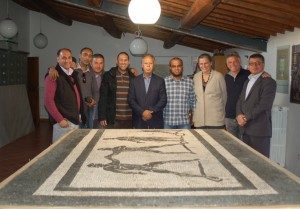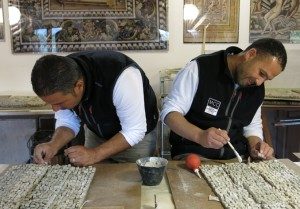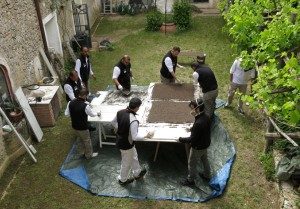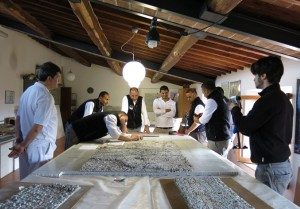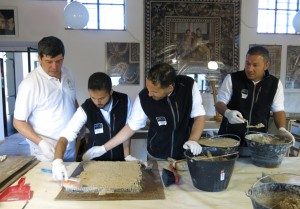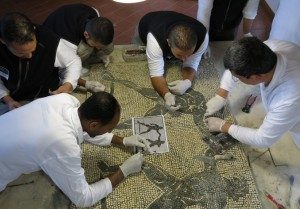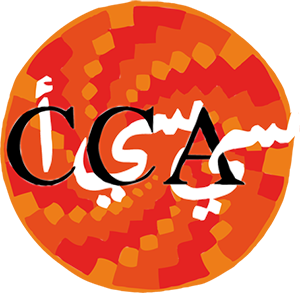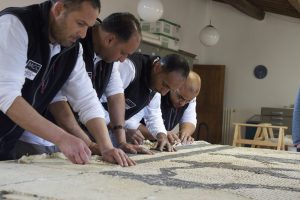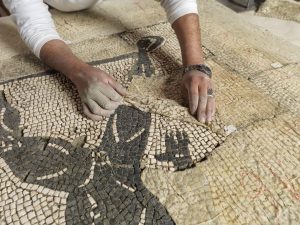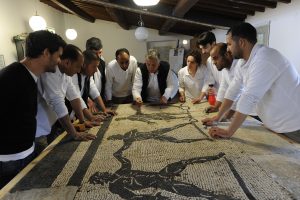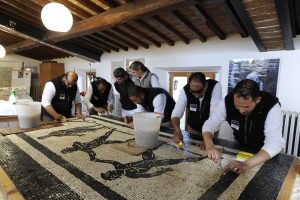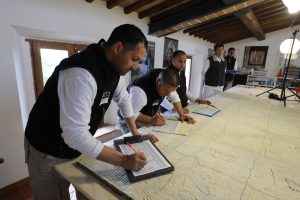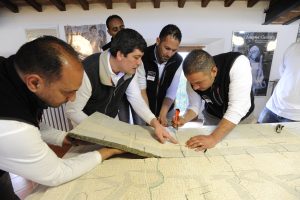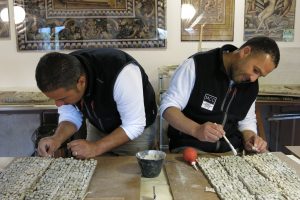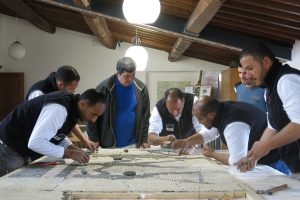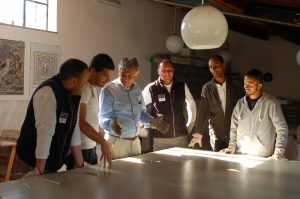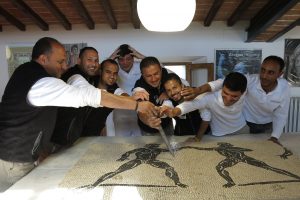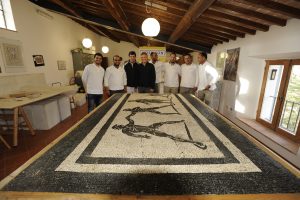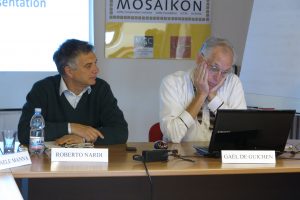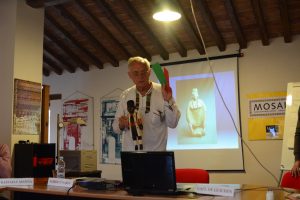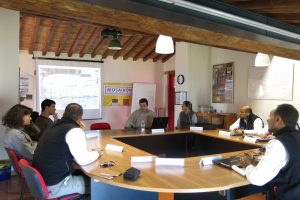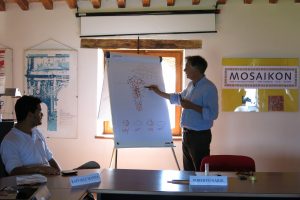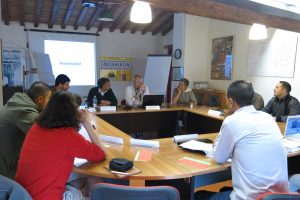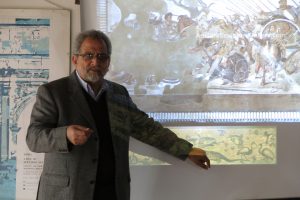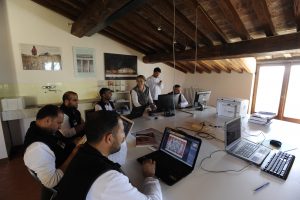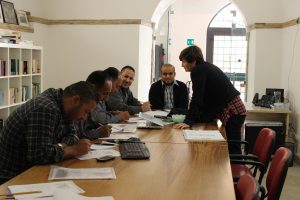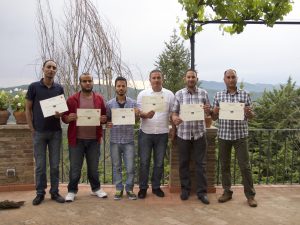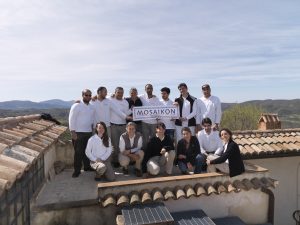The treatment of the Pietra Papa mosaic
Practical work is a central aspect of all MCC courses, and much attention has been dedicated to activities in the laboratory.
Across the two modules of MCC Libya 2014, participants undertook a complete conservation intervention on a Roman mosaic.
The so-called “Pietra Papa mosaic” comes from the thermal baths of a villa on Via Portuense in Rome, dated to Adrian’s period (2nd cen. A.D.).
The mosaic, 169 x 269 cm large, is composed by black and white stone tesserae, and it depicts figures of athletes engaged in sport training.
The Museo delle Terme of Roma has kindly made the mosaic available for the MCC Libya 2014 course.
There is no precise reference to the period when the mosaic was detached from the site, moved to Museo delle Terme, and placed on the floor with reinforced cement. It is known that, in order to prevent visitors from walking on the mosaic, in the 1990s the Museum’s Direction had it detached again, and deposited it in the storage, where it had stayed until its recovery and transportation in the CCA’s laboratories. The second detachment intervention was carried out according to the method of the “small pieces”, in sections of small dimensions.
The 31 fragments composing the mosaic were in good conservation conditions, showing evident signs of the previous restoration, such as presence of cement on the back of tesserae and large modifications in the tassellatum.
Participants carried out the whole conservation process in all its phases, from the initial documentation to the mounting on a new support, under the supervision of Roberto Cassio, responsable of the laboratory of mosaic conservation in the Vatican Museums.
The operations undertaken by the participants across the two modules of MCC Libya 2014 were the following ones:
- Preliminary cleaning of incoherent deposits from the reverse side of the fragments, with extractors and large soft brushes.
- Preliminary documentation: single fragments were photographically documented on the reverse side, the images acquired were digitally elaborated by Photoshop, and reassembled to compose the whole mosaic. All the information visible on the reverse side of tesserae (integrations with restoration tesserae; lacunae; previous cuts) has been graphically recorded on the reassembled image. The whole restoration intervention has been similarly documented.
- Cleaning of the reverse side of the tesserae: cement residues from the previous restoration and remnants of original mortar were removed mechanically, using scalpels and chisels.
- Positioning on clay: individual mosaic sections were reassembled by applying them on a clay layer of about 5 cm. This layer acted as temporary support for the tassellatum during the following operations of turning the fragments upside-down and removing the old facing. The fragments on clay were placed next to each other, front up, to recompose the whole mosaic.
- Removal of facing and cleaning: the facing used for detachment was carefully removed, by poulticing with hot water that allowed the adhesive used in the past to become soluble. Adhesive residues were removed from the surface of tesserae with water, repeated brushing and by scalpel.
- Integration of small lacunae: lacunae in the tassellatum not wider than 5 tesserae were integrated with retrieved original tesserae.
- Study and planning of new cuts: each participant studied and proposed a subdivision of the mosaic in sections, for it to be reapplied on the new support. The guidelines were doing small cuts and achieving the highest possible disguise between the final panels.
- Facing and removal of clay: mosaic fragments were faced again with cotton gauge and flour glue in emulsion with acrylic resin. New cutting lines were drawn and the mosaic cut in sections. Following this, fragments were turned upside-down and every clay residue was removed from the reverse side.
- Planning of the mounting and preparation of a new support: mounting of fragments was carried out on ready-made aluminium honeycomb panels covered with fiberglass (Aerolam), 25 mm thick. Several panels were joined with fiberglass rods and epoxy resin to compose a single panel as large as the mosaic. All fragments were placed on this panel to recompose the whole surface of the mosaic. 8 sections were decided, according to the mosaic pattern, each of them composed by several fragments. Each section coincides with a panel, and once placed next to each other, these panels recompose the whole mosaic, perfectly disguising joints. The shape of the sections were drawn on the Aerolam panels, and after removing the mosaic fragments, supports were prepared. The 8 sections cut from the large panel were prepared with granulated volcanic lapilli and epoxy resin, to create a grip on the surface.
- Application on the new support: mosaic fragments were applied on the Aerolam panels with a mortar based on hydraulic lime, lime putty and aggregates of different grain sizes. After the initial curing of the mortar, the facing was removed and the correct setting of tassellatum checked, making adjustment and/or integrations where necessary.
